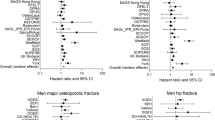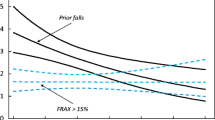Abstract
The higher incidence of fractures in women than in men is generally attributed to the lower areal bone mineral density (areal BMD, g/cm2) of the former. The purpose of the present study was to investigate both areal BMD and injurious falls as risk factors for fractures. In a first cohort, areal BMD was measured in 5,131 men and women (age range 40–95 years). In a second cohort, consisting of 26,565 men and women (age range 40–69 years), a health survey was conducted including questions about lifestyle and medication. Main outcome measures included validated prospective injurious falls and fractures in both cohorts. The higher areal BMD and femoral neck BMD in men compared to women (P < 0.001) were explained by a higher diameter of the femoral neck. Importantly, the diameter of the femoral neck was not associated with fractures in either sex (hazard ratio [HR] 0.94–1.04, P > 0.05 for all), suggesting that a higher areal BMD and lower incidence of osteoporosis in men do not explain their lower incidence of fractures. In contrast, women were more prone to sustain injurious falls than men in both cohorts investigated (HR for women = 1.61 and 1.84, P < 0.001 for both), resulting in a higher incidence of fractures (HR for women = 2.24 and 2.36, P < 0.001 for both). The number of injurious falls and fractures occurring each month during the study period showed a very strong correlation in both women (r = 0.95, P < 0.00001) and men (r = 0.97, P < 0.00001). In summary, low areal BMD, and thus osteoporosis, may not explain the higher fracture incidence in women than in men. Instead, a higher incidence of injurious falls in women was strongly associated with the higher fracture risk.

Similar content being viewed by others
References
Peck WA (1993) Consensus development conference: diagnosis, prophylaxis, and treatment of osteoporosis. Am J Med 94:646–650
Johnell O, Kanis JA (2006) An estimate of the worldwide prevalence and disability associated with osteoporotic fractures. Osteoporos Int 17:1726–1733
Johnell O, Kanis J (2005) Epidemiology of osteoporotic fractures. Osteoporos Int 16(2):S3–S7
Johnell O, Kanis JA, Oden A, Johansson H, De Laet C, Delmas P, Eisman JA, Fujiwara S, Kroger H, Mellstrom D, Meunier PJ, Melton LJ 3rd, O’Neill T, Pols H, Reeve J, Silman A, Tenenhouse A (2005) Predictive value of BMD for hip and other fractures. J Bone Miner Res 20:1185–1194
Cummings SR, Nevitt MC, Browner WS, Stone K, Fox KM, Ensrud KE, Cauley J, Black D, Vogt TM (1995) Risk factors for hip fracture in white women. Study of osteoporotic fractures research group. N Engl J Med 332:767–773
Cummings SR, Black DM, Nevitt MC, Browner W, Cauley J, Ensrud K, Genant HK, Palermo L, Scott J, Vogt TM (1993) Bone density at various sites for prediction of hip fractures. The study of osteoporotic fractures research group. Lancet 341:72–75
Looker AC, Wahner HW, Dunn WL, Calvo MS, Harris TB, Heyse SP, Johnston CC Jr, Lindsay R (1998) Updated data on proximal femur bone mineral levels of US adults. Osteoporos Int 8:468–489
Jarvinen TL, Sievanen H, Khan KM, Heinonen A, Kannus P (2008) Shifting the focus in fracture prevention from osteoporosis to falls. BMJ 336:124–126
Tinetti ME, Baker DI, McAvay G, Claus EB, Garrett P, Gottschalk M, Koch ML, Trainor K, Horwitz RI (1994) A multifactorial intervention to reduce the risk of falling among elderly people living in the community. N Engl J Med 331:821–827
Jensen J, Lundin-Olsson L, Nyberg L, Gustafson Y (2002) Fall and injury prevention in older people living in residential care facilities. A cluster randomized trial. Ann Intern Med 136:733–741
Tinetti ME (2003) Clinical practice. Preventing falls in elderly persons. N Engl J Med 348:42–49
Alexander BH, Rivara FP, Wolf ME (1992) The cost and frequency of hospitalization for fall-related injuries in older adults. Am J Public Health 82:1020–1023
Kosorok MR, Omenn GS, Diehr P, Koepsell TD, Patrick DL (1992) Restricted activity days among older adults. Am J Public Health 82:1263–1267
Tinetti ME, Williams CS (1997) Falls, injuries due to falls, and the risk of admission to a nursing home. N Engl J Med 337:1279–1284
Sattin RW, Lambert Huber DA, DeVito CA, Rodriguez JG, Ros A, Bacchelli S, Stevens JA, Waxweiler RJ (1990) The incidence of fall injury events among the elderly in a defined population. Am J Epidemiol 131:1028–1037
Tinetti ME, Doucette J, Claus E, Marottoli R (1995) Risk factors for serious injury during falls by older persons in the community. J Am Geriatr Soc 43:1214–1221
Kannus P, Parkkari J, Koskinen S, Niemi S, Palvanen M, Jarvinen M, Vuori I (1999) Fall-induced injuries and deaths among older adults. JAMA 281:1895–1899
Luukinen H, Koski K, Honkanen R, Kivela SL (1995) Incidence of injury-causing falls among older adults by place of residence: a population-based study. J Am Geriatr Soc 43:871–876
Nyberg L, Gustafson Y, Janson A, Sandman PO, Eriksson S (1997) Incidence of falls in three different types of geriatric care. A Swedish prospective study. Scand J Soc Med 25:8–13
Weinehall L, Hallgren CG, Westman G, Janlert U, Wall S (1998) Reduction of selection bias in primary prevention of cardiovascular disease through involvement of primary health care. Scand J Prim Health Care 16:171–176
Lindahl B, Weinehall L, Asplund K, Hallmans G (1999) Screening for impaired glucose tolerance. Results from a population-based study in 21, 057 individuals. Diabetes Care 22:1988–1992
Carter DR, Bouxsein ML, Marcus R (1992) New approaches for interpreting projected bone densitometry data. J Bone Miner Res 7:137–145
Riggs BL, Melton LJ 3rd, Robb RA, Camp JJ, Atkinson EJ, Oberg AL, Rouleau PA, McCollough CH, Khosla S, Bouxsein ML (2006) Population-based analysis of the relationship of whole bone strength indices and fall-related loads to age- and sex-specific patterns of hip and wrist fractures. J Bone Miner Res 21:315–323
Sigurdsson G, Aspelund T, Chang M, Jonsdottir B, Sigurdsson S, Eiriksdottir G, Gudmundsson A, Harris TB, Gudnason V, Lang TF (2006) Increasing sex difference in bone strength in old age: the Age, Gene/Environment Susceptibility-Reykjavik Study (AGES-REYKJAVIK). Bone 39:644–651
Sievanen H (2000) A physical model for dual-energy X-ray absorptiometry–derived bone mineral density. Invest Radiol 35:325–330
Rivadeneira F, Zillikens MC, De Laet CE, Hofman A, Uitterlinden AG, Beck TJ, Pols HA (2007) Femoral neck BMD is a strong predictor of hip fracture susceptibility in elderly men and women because it detects cortical bone instability: the Rotterdam Study. J Bone Miner Res 22:1781–1790
Kaptoge S, Beck TJ, Reeve J, Stone KL, Hillier TA, Cauley JA, Cummings SR (2008) Prediction of incident hip fracture risk by femur geometry variables measured by hip structural analysis in the study of osteoporotic fractures. J Bone Miner Res 23:1892–1904
Parkkari J, Kannus P, Palvanen M, Natri A, Vainio J, Aho H, Vuori I, Jarvinen M (1999) Majority of hip fractures occur as a result of a fall and impact on the greater trochanter of the femur: a prospective controlled hip fracture study with 206 consecutive patients. Calcif Tissue Int 65:183–187
Stevens JA, Sogolow ED (2005) Gender differences for non-fatal unintentional fall related injuries among older adults. Inj Prev 11:115–119
Englander F, Hodson TJ, Terregrossa RA (1996) Economic dimensions of slip and fall injuries. J Forensic Sci 41:733–746
Tinetti ME, Speechley M, Ginter SF (1988) Risk factors for falls among elderly persons living in the community. N Engl J Med 319:1701–1707
Rubenstein LZ (2006) Falls in older people: epidemiology, risk factors and strategies for prevention. Age Ageing 35 Suppl 2:ii37–ii41
Law MR, Hackshaw AK (1997) A meta-analysis of cigarette smoking, bone mineral density and risk of hip fracture: recognition of a major effect. BMJ 315:841–846
Kanis JA, Johnell O, Oden A, Johansson H, De Laet C, Eisman JA, Fujiwara S, Kroger H, McCloskey EV, Mellstrom D, Melton LJ, Pols H, Reeve J, Silman A, Tenenhouse A (2005) Smoking and fracture risk: a meta-analysis. Osteoporos Int 16:155–162
Nelson HD, Nevitt MC, Scott JC, Stone KL, Cummings SR (1994) Smoking, alcohol, and neuromuscular and physical function of older women. Study of Osteoporotic Fractures Research Group. JAMA 272:1825–1831
Eklund F, Nordstrom A, Neovius M, Svensson O, Nordstrom P (2009) Variation in fracture rates by country may not be explained by differences in bone mass. Calcif Tissue Int 85:10–16
Author information
Authors and Affiliations
Corresponding author
Additional information
The authors have stated that they have no conflict of interest.
Rights and permissions
About this article
Cite this article
Nordström, P., Eklund, F., Björnstig, U. et al. Do Both Areal BMD and Injurious Falls Explain the Higher Incidence of Fractures in Women than in Men?. Calcif Tissue Int 89, 203–210 (2011). https://doi.org/10.1007/s00223-011-9507-z
Received:
Accepted:
Published:
Issue Date:
DOI: https://doi.org/10.1007/s00223-011-9507-z




